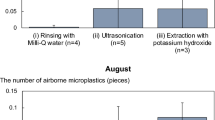Abstract
Wettability and retention capacity of leaf surfaces are parameters that contribute to interception of rain, fog or dew by forest canopies. Contrary to common expectation, hydrophobicity or wettability of a leaf do not dictate the stickiness of drops to leaves. Crucial for the adhesion of drops is the contact angle hysteresis, the difference between leading edge contact angle and trailing edge contact angle for a running drop. Other parameters that are dependent on the static contact angle are the maximum volume of drops that can stick to the surface and the persistence of an adhering drop with respect to evaporation. Adaption of contact angle and contact angle hysteresis allow one to pursue different strategies of drop control, for example efficient water shedding or maximum retention of adhering water. Efficient water shedding is achieved if contact angle hysteresis is low. Retention of (isolated) large drops requires a high contact angle hysteresis and a static contact angle of 65.5°, while maximum retention by optimum spacing of drops necessitates a high contact angle hysteresis and a static contact angle of 111.6°. Maximum persistence with respect to evaporation is obtained if the static contact angle amounts to 77.5°, together with a high contact angle hysteresis. It is to be expected that knowledge of these parameters can contribute to the capacity of a forest to intercept water.






Similar content being viewed by others
References
Aboal, J.R., Jiménez, M.S., Morales, D., Hernández, J.M. (1999), Rainfall interception in laurel forest in the Canary Islands. Agricultural and Forest Meteorology 97, 73–86.
Aston, A.R. (1979), Rainfall interception by eight small trees. Journal of Hydrology 42, 383–396.
Atkins, P., Physical Chemistry (W.H. Freeman, New York 1998).
Barthlott, W., Neinhuis, C. (1997), Purity of the sacred lotus, or escape from contamination in biological surfaces. Planta 202, 1–8.
Breshears, D., McDowell, N.G., Goddard, K. L., Dayem, K. E., Martens, S. N., Meyer, C. W., Brown, K. M. (2008), Foliar absorption of intercepted rainfall improves woody plant water status most during drought. Ecology 89, 41–47.
Burgess, S.S.O., Dawson, T.E., (2004), The contribution of fog to the water relations of Sequoia sempervirens (D. Don): foliar uptake and prevention of dehydration. Plant, Cell and Environment 27, 1023–1034.
Burkhardt, J. (2010), Hygroscopic particles on leaves: nutrients or desiccants? Ecological Monographs, 80, 369–399.
Calder, I. (1990), Evaporation in the uplands. John Wiley and sons Inc., Chichester. 149 pp.
Calies, M., Quéré, D. (2005), On water repellency. Soft Matter 1, 55–61.
Dimitrakopoulos, P., and Higdon, J.J.L. (1998), On the displacement of three-dimensional fluid droplets from solid surfaces in low-Reynolds-number shear flows, J. Fluid Mech. 377, 189–222.
Dimitrakopoulos, P., and Higdon, J.J.L. (1999), On the gravitational displacement of three-dimensional fluid droplets from inclined solid surfaces, J. Fluid Mech. 395, 181–209.
Dingman, S., Physical hydrology (Prentice Hall, Upper Saddle River 2002).
Extrand, C.W., and Kumagai, Y., (1995), Liquid drops on a inclined plane: the relation between contact angles, drop shape, and retentive force. Journal of Colloid and Interface Science 170, 515–521.
Feng, L., Zhang, Y.A., Xi, J.M., Zhu, Y., Wang, N., Xia, F., Jiang, L. (2008), Petal effect: Two major examples of the Cassie-Baxter model are the Petal effect and Lotus effect. A superhydrophobic state with high adhesive force. Langmuir 24, 4114–4119.
Gash, J.H.C. (1979), An analytical model of rainfall interception by forests. Journal of Hydrology 105, 43–55.
Glasner, K.B. (2007), The dynamics of pendant droplets on a one-dimensional surface, Physics od Fluids 19, 102–104.
Herwitz, S.R. (1985), Interception storage capacities of tropical rainforest canopy trees. Journal of Hydrology 77, 237–252.
Hörman, G., Branding, A., Clemen, T., Herbst, M., Hinrichs, A. (1996), Calculation and simulation of wind controlled canopy interception of beech forest in Northern Germany. Agricultural and Forest Meteorology 79, 131–148.
Holder, C.D. (2007), Leaf water repellency of species in Guatemala and Colorado (USA) and its significance to forest hydrology studies. Journal of Hydrology 336, 147–154.
Muzylo, A., Llorens, P., Valente, F., Keizer, J.J., Domingo, F., Gash, J.H.C. (2009), A review of rainfall interception modelling. Journal of Hydrology 370, 191–206.
Petrissans, M., and Cscapo, E. (2003), Retention of glycerol sessile drop on MDF wood material, Holz als Roh- und Werkstoff, 61, 12–116.
Podgorski, T., Flesselles, J.-M., and Limat, L. (2001), Corners, Cusps, and Pearls in Running Drops, Phys. Rev. Lett. 87, 036102.
Quréré, D. (2008), Wetting and roughness. Annual Review of Materials Research 38, 71–99.
Reif, F., Fundamentals of statistical and thermal physics (McGraw-Hill, New York 1974).
Shirtcliffe, N.J., McHale, G., Newton, M.I. (2009), Learning from superhydrophobic plants: The use of hydrophilic areas on superhydrophobic surfaces for droplet control. Langmuir 25, 14121–14128.
Acknowledgments
This work was supported by the German Federal Ministry of Education and Research by a grant to A. R. -N., within the project 02WT0906.
Author information
Authors and Affiliations
Corresponding author
Rights and permissions
About this article
Cite this article
Konrad, W., Ebner, M., Traiser, C. et al. Leaf Surface Wettability and Implications for Drop Shedding and Evaporation from Forest Canopies. Pure Appl. Geophys. 169, 835–845 (2012). https://doi.org/10.1007/s00024-011-0330-2
Received:
Revised:
Accepted:
Published:
Issue Date:
DOI: https://doi.org/10.1007/s00024-011-0330-2




